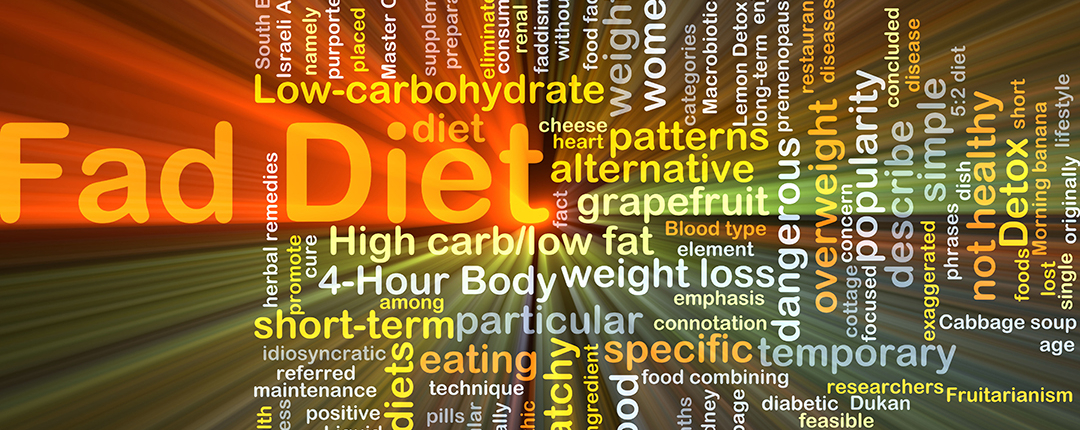Looking for a fast way to lose weight- should you try a fast/fad diet?
You may be looking for a fast way to lose weight or castaway to fitness and there’s no shortage of ‘fad diets’ around. These ‘diets’ may provide short-term results, but they are difficult to sustain and, ultimately, they deprive you of the essential nutrients that only balanced eating can offer.
FAD Diets vs HEALTHY EATING PLAN- which will help me to lose weight and keep it off?
What are ‘Fad’Diets? – A fad diet is a diet that promises quick weight loss through what is usually an unhealthy and unbalanced diet. Fad diets are targeted at people who want to lose weight quickly without exercise.
Fad diets:
- Promise a quick fix
- Promote ‘magic’ foods or combinations of foods fad
- Implies that food can change body chemistry
- Excludes or severely restricts food groups or nutrients, such as carbohydrates
- Has rigid rules that focus on weight loss
- Because they often cut out key foods, fad diets may cause the following symptoms:
- Dehydration
- Weakness
- Nausea and headaches
- Constipation
- Inadequate vitamin and mineral intake.
Fad diets that severely restrict food groups or nutrients may also mean that you miss the protective health effects that a balanced eating plan provides. No-one knows whether fad diets are safe over the longer term, or whether they lead to an increased risk of various diseases.
Healthy eating plan.
With a balanced eating plan, it’s what you leave in that makes all the difference. For a balanced eating plan to be successful, you need to:
- Eat plenty of vegetables, legumes and fruits.
- Include a variety of cereals (including breads, rice, pasta and noodles), preferably wholegrain.pic 1 healthy eatng
- Include lean meat, fish, poultry or alternatives.
- Include milk, yoghurts, cheeses or alternatives.
- Drink plenty of water.
- Limit saturated fat and moderate total fat intake.
- Choose reduced fat varieties of foods where possible.
- Choose foods low in salt.
- Limit your alcohol intake, if you choose to drink.
- Consume only moderate amounts of sugars, and food and drinks containing added sugars. In particular, limit sugar-sweetened beverages.
Carbohydrates provide the body with kilojoules, or fuel. Foods that contain the most carbohydrates include:
- Fruit
- Vegetables, especially potatoes and corn
- Legumes, including dried beans, peas and lentils
- Grains
- Bread
- Breakfast cereal
- Rice, pasta and noodles
- Low-fat milk and yoghurt.
These foods are rich in vitamins and minerals and are generally low in fat. This makes them well suited to a healthy eating plan. Some are excellent sources of dietary fibre, including wholegrain varieties, legumes, fruit and vegetables
Once you have a healthy eating pattern, you’ll soon feel like you have more energy and you’ll want to be more active. To make it easier for you to get the right amount of physical activity each day, here are a few suggestions:
- Think of movement as an opportunity, not an inconvenience. physical-activity
- Put together at least 30 minutes of moderate intensity physical activity on most, preferably all, days.
- Enjoy some regular, vigorous exercise if you can for extra health and fitness.
- Remember, the more activity you do, the greater the benefits you’ll enjoy.
- Changing your eating and physical activity habits can be difficult at first. But once you’ve started, it’ll be easy to sustain. Here are a few tips to help ease the transition:
- Combine an active lifestyle with healthy eating
- Make small, achievable, lifelong changes to your lifestyle and eating habits.
- Fill up on low-kilojoule nutritious foods.
- Keep portions moderate in size.
- Eat until you have had enough – not until you are full.
- Do your best to avoid eating when you are not hungry.
- Recognise that on some days you might be hungrier than on other days.
- Eat slowly and enjoy your food.
- Eat regular meals including breakfast, lunch and dinner.
- Reduce the amount of ‘extra’ or ‘sometimes’ foods that you eat.
Examples of ‘sometimes’ foods include biscuits, cakes, desserts, pastries, soft drinks and high fat snack items such as crisps, pies, pasties, sausage rolls, other takeaway foods, lollies and chocolate.
Healthy food and physical activity will give you more energy and leave you feeling healthier. You will also be able to set a good example for your children and look after your family by offering them healthy food.
Once a wide range of nutritious foods and physical activity become part of your everyday routine, it won’t feel like your dieting.




